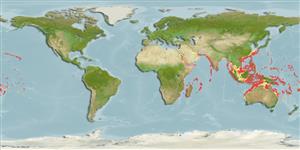Environment: milieu / Zona climática / intervalo de profundidade / distribution range
Ecologia
marinhas associadas(os) a recifes; não migratória; intervalo de profundidade 40 - 300 m (Ref. 89972), usually 100 - 250 m (Ref. 9710). Tropical; 30°N - 59°S, 29°E - 150°W (Ref. 5222)
Indo-Pacific: islands of the western Indian Ocean to Japan and the central Pacific. Except for a single specimen caught off the coast of Natal, South Africa, Heemstra and Randall 1993 know of no confirmed records from other continental localities of East Africa. Cephalopholis aurantia from east Africa reported by Morgans 1982 (Ref. 6448) is a misidentification of Cephalopholis nigripinnis.
Tamanho / Peso / Idade
Maturidade: Lm ? range ? - ? cm
Max length : 60.0 cm TL macho/indeterminado; (Ref. 4319); common length : 30.0 cm TL macho/indeterminado; (Ref. 5450)
Espinhos dorsais (total) : 9; Raios dorsais (total) : 14 - 16; Espinhos anais: 3; Raios anais : 8 - 9. Pale orange-red to orange-yellow or golden with red or yellow dots on head, anterodorsally on body, and on base of dorsal fin. Posterior margin of caudal fin with a pale blue edge and black submarginal line; posterior parts of dorsal and anal fins often with a narrow pale blue edge; further characterized by having ctenoid scales on body including most of abdomen; greatest body depth 2.5-3.0 in SL; rounded caudal fin; pelvic fins usually reaching anus, 1.6-2.0 in head length (Ref. 90102); head length 2.4-2.6 times in SL; interorbital area flat; rounded preopercle, finely serrate, lower edge fleshy; subopercle and interopercle serrate; scaly maxilla, reaching to or beyond vertical at rear edge of eye (Ref. 89707).
Body shape (shape guide): fusiform / normal; Cross section: oval.
Rare species (Ref. 4319). Found on steep seaward reefs (Ref. 9710). Museum specimens are lacking. Usually at depths of 100-250 m, but can occur in shallower water (Ref. 89707). Feeds mainly on crabs (Ref. 89972). Solitary (Ref 90102).
Ciclo de vida ou comportamento de acasalamento
Maturidade | Reprodução | Desova | Ovos | Fecundidade | Larvas
Heemstra, P.C. and J.E. Randall, 1993. FAO Species Catalogue. Vol. 16. Groupers of the world (family Serranidae, subfamily Epinephelinae). An annotated and illustrated catalogue of the grouper, rockcod, hind, coral grouper and lyretail species known to date. Rome: FAO. FAO Fish. Synop. 125(16):382 p. (Ref. 5222)
Status na Lista Vermelha da UICN (Ref. 130435: Version 2025-1)
Ameaça para os humanos
Harmless
Uso pelos humanos
Pescarias: pouco comercial
Ferramentas
Relatórios especiais
Baixar XML
Fontes da internet
Estimates based on models
Preferred temperature (Ref.
123201): 13.1 - 25, mean 19.1 °C (based on 438 cells).
Índice de diversidade filogenética (Ref.
82804): PD
50 = 0.5000 [Uniqueness, from 0.5 = low to 2.0 = high].
Bayesian length-weight: a=0.01259 (0.00587 - 0.02699), b=3.04 (2.87 - 3.21), in cm total length, based on LWR estimates for this Genus-body shape (Ref.
93245).
Nível Trófico (Ref.
69278): 4.0 ±0.65 se; based on food items.
Resiliência (Ref.
120179): médio(a), tempo mínimo de duplicação da população 1,4 - 4,4 anos (Preliminary K or Fecundity.).
Fishing Vulnerability (Ref.
59153): Moderate vulnerability (44 of 100).
🛈
Nutrients (Ref.
124155): Calcium = 32.8 [17.5, 54.9] mg/100g; Iron = 0.437 [0.239, 0.833] mg/100g; Protein = 18.6 [16.7, 20.2] %; Omega3 = 0.178 [0.109, 0.295] g/100g; Selenium = 57.9 [29.9, 100.8] μg/100g; VitaminA = 82.8 [30.0, 262.9] μg/100g; Zinc = 0.748 [0.512, 1.205] mg/100g (wet weight);
